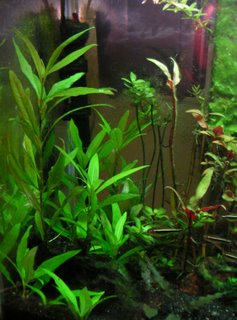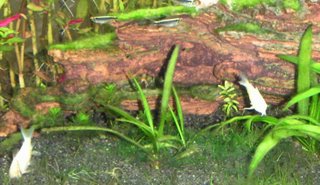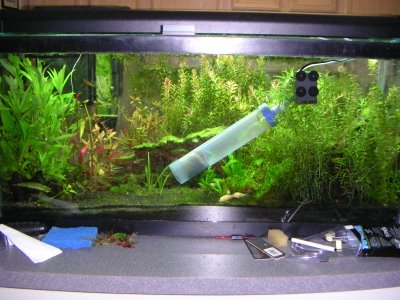Removal for Some Algae, Thriving for Others
 For some reason (probably nutrient related), the temple on the left-hand side has just been getting decimated. The leaves and stems have been turning brown and flimsy and basically disintegrating, so I have gone from having too much to not enough of it. I cut off the healthy looking tops of a few whose bases had decayed and I tried to locate and remove all the rotted bits. I'm hoping the replanted plant tops will put down roots and try again.
For some reason (probably nutrient related), the temple on the left-hand side has just been getting decimated. The leaves and stems have been turning brown and flimsy and basically disintegrating, so I have gone from having too much to not enough of it. I cut off the healthy looking tops of a few whose bases had decayed and I tried to locate and remove all the rotted bits. I'm hoping the replanted plant tops will put down roots and try again.Additional problems include a nice algae film covering the bottom of the tank and choking out the hairgrass. It's even growing on the rotala indica when it's closed up for the night and preventing it from reopening in the morning. I believe it's blue-green algae (cyanobacteria) and one article indicated it was caused by excessive nutrients and waste. Sure enough, when I checked nitrates, they were off the charts!
 This is a tank the previously read less nitrates than the tap water! So, while it initially helped curb the hair algae, the ferts I added were obviously too much for the tank to handle, and I've accumulated far too many nitrates.
This is a tank the previously read less nitrates than the tap water! So, while it initially helped curb the hair algae, the ferts I added were obviously too much for the tank to handle, and I've accumulated far too many nitrates.The neons I had been keeing in the 5 gallon have never really thrived, and recently when I checked on them, I noticed their numbers had dwindled to three (from six). I decided enough was enough, so I moved the three remaining neons to the bucket (nitrates in there were only 20 ppm). Hopefully they will feel a little safer there, and the bio-load in the 5-gallon will be reduced.

